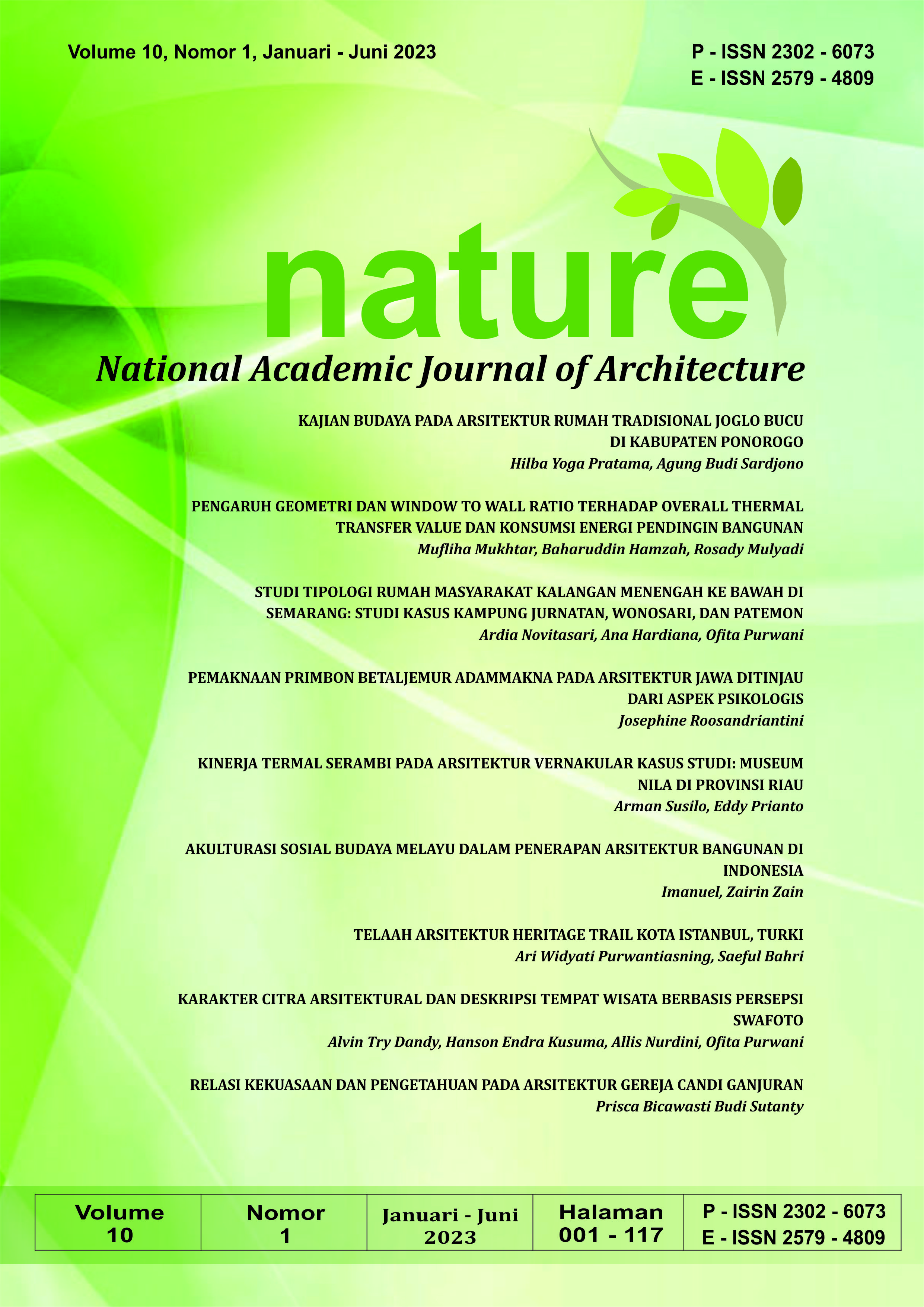KINERJA TERMAL SERAMBI PADA ARSITEKTUR VERNAKULAR KASUS STUDI: MUSEUM NILA DI PROVINSI RIAU
Abstract
The Sang Nila Utama museum building is a vernacular architectural form of traditional buildings that have changed from Riau Malay architecture. This shape change certainly affects the thermal performance of the building itself, which in turn will lead to thermal comfort. Comfort is influenced by a) temperature (oC), b) relative humidity (%), c) wind speed (m/s), and d) MRT (mean radiant temperature). This study aims to determine the thermal performance of the building corridor in terms of spatial climatic factors on temperature and humidity. The method used in this study is a quantitative descriptive correlation, measuring variables of temperature and humidity in the museum corridor and interior. The results of research on the temperature variable in 2 (two) days showed a deasedecreasehe the average thermal performance of the microclimate on the porch of 0.2%, which was shown from the + (positive) value, and from the porch to the interior, there was an increase of 1%, which was shown from the value - (negative). From the average value of the temperature variable, the museum is out of a comfortable condition according to SNI T-14-1993-03.
Downloads
References
Abdullah AM. Hamid M., (2011)Perbandingan tingkat kenyamanan termal dua rumah tradisional Bugis di Malaysia.Prosiding Konferensi Internasional ke-12 tentang Lingkungan dan Arsitektur Berkelanjutan (SENVAR). Malang: Universitas Brawijaya, Indonesia.
Alfata MN, Suwantara IK, (2011), Pengaruh pengaruh Bentuk Atap terhadap Kinerja Termal Bangunan; Kajian Rumah Adat Kaka Pu'u dan Sonaf. Prosiding Konferensi Internasional ke-12 tentang Lingkungan dan Arsitektur Berkelanjutan (SENVAR).Malang: Universitas Brawijaya, Indonesia.
Almusaed, A., (2011), Biophilic and Bioclimatic Architecture, Springer-Verlag London Limited 2011.
Gupta, J., Chakraborty, M., Paul, A., & Korrapatti, V. (2017). A comparative study of thermal performances of three mud dwelling units with courtyards in composite climate. Journal of Architecture and Urbanism, 41(3), 184–198. https://doi.org/10.3846/20297955.2017.1355276.
Maryna, D., Erna, N., Era, M., & Rauzi, N. (2020). Evaluasi Kenyamanan Termal pada Rumah Panggung Modifikasi di Gampong Jawa Kota Banda Aceh. Jurnal Ilmiah Mahasiswa Arsitektur Dan Perencanaan, 4(3), 72–78.
Nugroho AM., (2012). Kajian termal rumah adat di Flores, Indonesia. Jurnal Penelitian Ilmiah Dasar dan Terapan; 2(12), hal.12795-12801.
Pajek, Luka, and Mitja Košir. (2017). Can Building Energy Performance Be Predicted by a Bioclimatic Potential Analysis? Case Study of the Alpine-Adriatic Region. Energy and Buildings 139 (March): 160–73. https://doi.org/10.1016/J.ENBUILD.2017.01.035.
Pamungkas, L. S., & Ikaputra, I. (2020). Local Wisdom Arsitektur Tradisional Dan Kenyamanan Termal Tropis. Jurnal Arsitektur ARCADE, 4(2), 160. https://doi.org/10.31848/arcade.v4i2.350.
Prasetyo HY,.Fajri A. M. N., Pasaribu A. R., (2013). Typology of Malay Traditional House Rumah Lontiok and its Response to the Thermal Environment Procedia Environmental Sciences 20(2014) 162–171
Pratama, D. A., & Budiono, I. Z. (2021). Perancangan Jendela dan Partisi Pembatas dengan Pertimbangan Kenyamanan Termal. 6(2), 55–64.
Prianto E., (2022). Belajar Mengkaji Kinerja Termal pada Loteng Atap Kampung (Studi Eksperimen dengan Rumah Model). In: Puspa Ragam Bentuk-Bentuk Arsitektur Setempat. PenerbitTigamedia,pp.115-139. https://eprints2.undip.ac.id/id/eprint/9317/.
Q. Liang, (2005). Tropical Semi-open Entrance Space: Solar and Wind Effects on Thermal Comfort (Master Thesis), National University of Singapore, 2005.
Soedjarwo MP. (2011). Pembukaan rumah atap Joglo sebagai strategi pendinginan pasif.Prosiding Konferensi Internasional ke-12 tentang Lingkungan dan Arsitektur Berkelanjutan (SENVAR). Malang: Universitas Brawijaya, Indonesia.
Sugini. (2014). Kenyamanan Termal Ruang ; Konsep dan Penerapan pada Desain. Graha Ilmu Yoyakarta ISBN : 978-602-262-175-1.
Suwantara IK, Nugrahaeni R, Suprijanto I., (2011). Pertunjukan termal rumah adat Sao Ria di Ngalupolo dan Nggela (Hujan dan kemarau).Prosiding Konferensi Internasional ke-12 tentang Lingkungan dan Arsitektur Berkelanjutan (SENVAR). Malang: Universitas Brawijaya, Indonesia.
Wang, Z., Xue, Q., Ji, Y., & Yu, Z. (2018). Indoor environment quality in a low-energy residential building in winter in Harbin. Building and Environment, 135(March), 194–201. https://doi.org/10.1016/j.buildenv.2018.03.012.
Yousefi, F.; Nocera, F. (2021). The Role of Ab-Anbars in the Vernacular Architecture of Iran with Emphasis the Performance of Wind-Catchers in Hot and Dry Climates. Heritage 2021, 4, 3987–4000.https://doi.org/10.3390/heritage 4040219.
Zaini, M. (2017). Mengenal Rumah Melayu Riau. Kementerian Pendidikan dan Kebudayaan Badan Pengembangan dan Pembinaan Bahasa Jakarta Timur. ISBN: 978-602-437-232-3.
Copyright (c) 2023 Arman Susilo, Eddy Prianto

This work is licensed under a Creative Commons Attribution-ShareAlike 4.0 International License.
By submitting your manuscript to our journal, you are following Copyright and License











